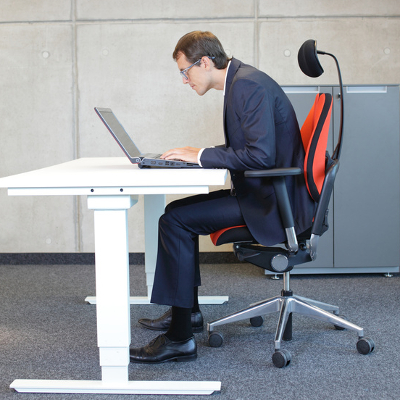It’s not uncommon to feel tired after a long day at work, but do you ever feel physically drained – even after a relatively stress-free day? The modern workplace often involves hours sitting at a desk. You could be experiencing eye strain from staring at a screen all day. Immobility can cause back pain. Constant typing can cause repetitive strain injury. Have you experienced any of these? If so your workstation might be in need of an ergonomic makeover.
Let’s take a look at how you should be sitting when you work at a computer. Some simple adjustments can help you be more comfortable at work. This will also help you to boost your productivity levels and improve your work efficiency. CNet has offered some suggestions about ergonomic adjustments to implement in the office:
Find the Best Sitting Position
Are you aware of what the most comfortable way for you to sit actually is? Here’s how to optimize your sitting position. Sit down and relax. You can even close your eyes if you wish, as long as you stay awake. You may shift around a bit to start with, but after a while you’ll find that you’ve settled into a comfortable position. You’ve hit the comfort sweet spot. Try to stick with it when you work.
Your Mouse and Keyboard
Now that you’re sitting comfortably you need to envisage your ideal workstation arrangement. In the comfortable seated position that you’ve just identified, try using your mouse and keyboard. Ideally, your keyboard should be no more than two inches above your thighs and you should be able to keep your elbows comfortably at your side. If the desk is too high, consider using a keyboard tray, which attaches underneath your desk (and it will help declutter your desk too).
When you’re sitting correctly, the distance between your hands should be the same as the width of your shoulders. The next thing to consider is wrist position. A wrist rest can help. It stops you using your hands in an unnatural position that can lead to poor circulation and nerve compression (as in carpal tunnel syndrome). Your wrists should be slightly bent, not flat on the desk surface.
Position Your Screen(s)
Your monitor should be placed correctly to avoid neck strain. To optimize the placement of your screen, stretch out your arm. You should just be able to touch it. If you use more than one screen, the same principle applies. Place them at a slight angle so that they are just at touching distance, and no closer. The height of the screen is also important. Aim for a height at which your browser’s search bar is at eye level. Also be aware of glare. Don’t set it to brighter than necessary, and if you can tilt the screen downward slightly this will also reduce glare.
The Ideal Chair
A comfortable chair is all-important. If your current chair isn’t suitable then a new one could be a worthwhile investment. One of the most important things is lumbar support. You should also have a couple of inches of space between the chair and the inside of your knee. The height will be determined by the height of the desk. If your feet don’t touch the floor, use a footrest. This will stop nerve compression that can make your feet go to sleep (sometimes known as ‘jello foot syndrome’).
You’ll find work much easier if you’re comfortable and, conversely, being uncomfortable is a huge obstacle to productivity. Ergonomics is about the way that a properly organized working environment can aid efficiency and productivity. Do you have any tips about using ergonomic principles to make your workstation more comfortable? Tell us in the comments.

